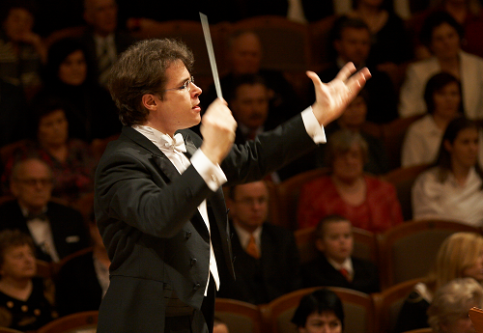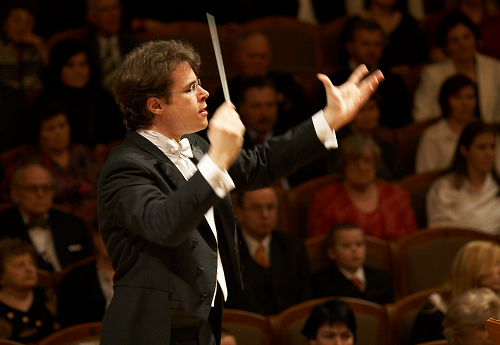
 Germany Musikfest Berlin 2016 [4]– Ligeti. Neuwirth, Dvořák: Robyn Schulkowsky (percussion), Deutsches Symphonie-Orchester Berlin/Jakub Hrůša (conductor), Philharmonie, Berlin, 11.9.2016. (MC)
Germany Musikfest Berlin 2016 [4]– Ligeti. Neuwirth, Dvořák: Robyn Schulkowsky (percussion), Deutsches Symphonie-Orchester Berlin/Jakub Hrůša (conductor), Philharmonie, Berlin, 11.9.2016. (MC)

Ligeti: Concert Românesc
Neuwirth: Trurliade-Zone Zero
Dvořák: Symphony No. 4 in D minor
It was pleasing to have the opportunity of seeing the Deutsches Symphonie-Orchester Berlin again in concert. Having seen them perform over the last few years at the annual Musikfest its consistency and elevated level of performance is remarkable. Making his Musikfest Berlin debut Jakub Hrůša was conducting a fascinating programme so typical of the festival which comprised a revival of a highly accessible 20th century work by Ligeti, a new percussion concerto from the pen of Olga Neuwirth and a too frequently overlooked symphony by Dvořák.
Ligeti is usually associated with challenging a-tonal music such as his Requiem Atmosphères and Lontano, and it’s rare to attend performances of his works in the UK. Concert Românesc is the approachable face of Ligeti and the composition which audiences are most likely to hear; often programmed to open the concert. A relatively early work it was written in the 1950s during the days of the Soviet Union-led government in Hungary when composers were ordered to write music in a politically correct form for the people. Inspired by traditional folk music of his native Transylvania even the Concert Românesc was banned for a time. Highly successful was the interweaving of strikingly played solo wind instruments into the fabric of the score together with folk-dance rhythms of Romania and Hungary especially the klezmer on the clarinet. Appealing, lively and often boisterous under Jakub Hrůša’s baton Ligeti’s folk-infused score provided an uplifting opening.
The genre of the percussion concerto is one I have never especially warmed to, struggling to appreciate foremost examples namely the Bartók Sonata for two pianos and percussion, MacMillan’s Veni, Veni, Emmanuel, Torke’s Rapture et al although I did greatly appreciate Tobias Broström’s double concerto Theatron heard in concert at Dresden in 2015; a work that I hope has not sunk without trace. Receiving its German première Olga Neuwirth’s new work Trurliade-Zone Zero is the latest percussion concerto to enter the scene. In a programme note the composer states that the main impetus for the work was recalling the ‘typewriter scene’ with Jerry Lewis from the movie Who’s Minding the Store? (1963). Another source of inspiration was the effect algorithmic systems, which eliminate trader input, have over stock market trading. Neuwirth’s captivation with automation and the title of the piece Trurliade comes from Stanislaw Lem’s short science fiction story Trurl’s Machine about an inventor who creates a machine that thinks. Also influential were the sculptural machines created by Jean Tinguely and the work of artists Fischeli and Weiss. The term Zone Zero in the title refers to “the soloist breaking out of the isolation of a no-man’s land, his zone-zero.”
This 35 minute long concerto requires a soloist with an extremely large percussion station together with a full orchestra. 3 additional percussion stations are each manned by an orchestral player, positioned at the rear of the orchestra. Incidentally Robyn Schulkowsky replaced the original percussionist Martin Grubinger who had to cancel for personal reasons. At the front of the stage adjacent to the conductor Schulkowsky’s station was brimming with a vast array of percussion instruments. It seemed the only thing missing was the kitchen sink. Virtually occupied throughout, the energetic Schulkowsky started off by rubbing a rubber ball on a stick across a large upturned oil drum and concluded the work with battering the oil drum (actually a banana puree drum) with a giant wooden mallet. From the first note to the last, owing to the absence of memorable melodic content of the often thickly textured orchestral writing, the focus was on the visual theatrics and the sonic investigation of the percussion soloist. I can still recall many of the sounds made by the equipment at the 4 percussion stations notably an emergency siren, a man shouting “2 plus 2 is 7” from a megaphone, a turntable, wind sounds and finger clickers (the type of toy that used to be given away in children’s comics).
After a welcome rest from the exertions watching the percussion concerto the second half of the concert consisted of Dvořák Symphony No. 4 an inexplicably neglected work from the composer’s early 30s. Composed in 1874 and revised in 1887/88 the score shows influences of Wagner especially from Tannhauser and Die Meistersinger and Brahms too. The complete work was premièred in 1892 with Dvořák conducting.
Jakub Hrůša is clearly in his element with the fervour and rhythms of Dvořák’s soundworld with a sense of Czech nationalistic pride never far away. Highly pastoral in feeling is the opening movement, imbued with its sense of longing and reflection, with pride of place taken by the gloriously melodic waltz on the outstanding strings. In the Andante I relished the hymn-like brass fanfare supported by clarinets and bassoons and Hrůša made much of those lovely lilting melodies on the strings. Highly assured conducting ensured the melodies were suitably rousing in the Scherzo and passionately tender in the final movement. At one passage in the finale all the strings, bar the 8 basses, combined for quite glorious playing of a melting beauty rarely encountered.
Michael Cookson
